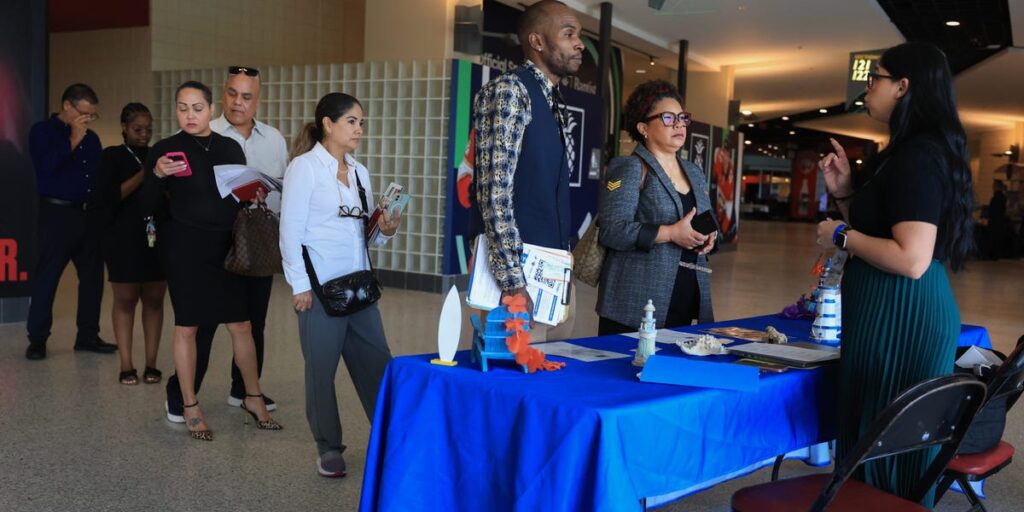Bundle up and hunker down. The low-fire, low-hire job market can be summed up in one phrase: the “Great Freeze.”
There are a lot of “lows” in the soft job market, including layoffs and unemployment. That’s the good news and has been the story for over a year. However, the not-so-good news is that job openings and hires have also dropped.
The lack of hiring and the lack of firing could have the same causes. Economists told Business Insider that the US hasn’t had large-scale layoffs because even though the economy is still strong, uncertainties around tariffs and other issues mean that companies are hanging on to the talent they have while being reluctant to hire more.
The low-fire, low-hire labor market has its pros and cons, including hindering potential career growth for workers but offering cost-saving measures for companies.
ZipRecruiter called the recent labor market “The Great Freeze” in a new report on recent turnover and hiring outlook.
“We’re seeing employers and job seekers both trying to wait out any of the uncertainty,” Nicole Bachaud, labor economist at ZipRecruiter, told Business Insider.
The lockup between low layoffs and low hiring might not end any time soon.
“We’re only a few months until the end of the year, and there isn’t an immediately obvious catalyst for why the job market would snap out of the malaise that it’s in,” Daniel Zhao, the chief economist at Glassdoor, said.
Why companies aren’t laying people off or hiring extensively
Jason Draho, the head of asset allocation Americas for UBS Global Wealth Management, said growth and consumer spending remain relatively solid, making it hard to justify large-scale layoffs.
“Earnings are still positive, businesses are still making money, and there’s not really a catalyst for them to reevaluate their head count,” said Stephen Juneau, a senior US economist at Bank of America.
Juneau said that uncertainty, artificial intelligence, pockets of economic weakness — such as in construction activity — and supply issues are affecting companies investing in new talent.
There are likely fewer workers entering the US these days, slowing labor force growth. “This negative labor supply shock obviously contributes to a slowdown in hiring,” Juneau said.
Supply issues combined with low hiring have also affected unemployment, which has risen but remains relatively low, Draho said.
Zhao said that employers are labor hoarding, or holding on to talent as a precaution, because they don’t want to relive previous staffing troubles. “After the experience during the Great Resignation and the labor shortages era, many businesses are hesitant to return to a world where they are desperate for workers and can’t find them,” he said.
Draho said that if next year has better growth, stimulus measures, and tariff clarity, then companies won’t want to be making mass layoffs now and then have to scramble for employees. “They don’t want to be caught short with a lack of labor,” he said.
ZipRecruiter’s September survey of talent acquisition professionals showed 63% of businesses intend to hire moderately or significantly more in the next year, down from 76% last year. “However, the current macroeconomic conditions are continuing to add delays and additional layers that are going to continue to keep hiring and movement in general at this slower pace for the next couple of months,” Bachaud said.
But labor hoarding could crumble if the economy worsens. “If employers have some cash or some buffer to work with, they can afford to keep some workers on staff, even if it isn’t profitable right now,” Zhao said. “I don’t expect this labor hoarding story to be able to protect against a full business cycle and recession where businesses are going to be forced to lay off workers.”
What today’s job market means for workers, job seekers, and employers
Zhao said labor hoarding can be good for workers because of job security, and unemployed people have less competition than if there were mass layoffs. However, many people are still actively seeking employment in the low-hiring, low-layoff environment. So, it can be tough to land a job. There were 7.4 million people unemployed in August, but only 7.2 million job openings were available; the number of job openings per unemployed person has cooled way down since the tight labor market recovery after the pandemic recession.
“Many workers have to settle for jobs that are not a good fit for them, whether they don’t pay commensurate with their experience or it’s not in a field or industry that they’re skills would best match,” Zhao said.
Lack of turnover can hinder professional development. Zhao said that low hiring affects jobholders who may want to secure a new job that offers better career growth opportunities or who wish to advance or negotiate a raise internally. The Atlanta Fed’s Wage Growth Tracker showed the 12-month moving averages of median wage growth were similar for job switchers and job stayers as of August.
“Employers who are focusing too much on stability and keeping everything as it is, keeping the status quo, are going to risk losing out to innovation and growth that’s not going to be happening if there’s no movement internally in their company,” Bachaud said. “Employees are going to be stuck in their role without growing and adding new skills and moving along their career paths.”
In the cool job market with workers staying put, Bachaud suggested people upskill within their roles so they can still grow and add to their résumé when they look for a new position.
Are you job searching, staying put in your job, or a hiring manager who has seen the workplace change? Reach out to this reporter to share at mhoff@businessinsider.com.


